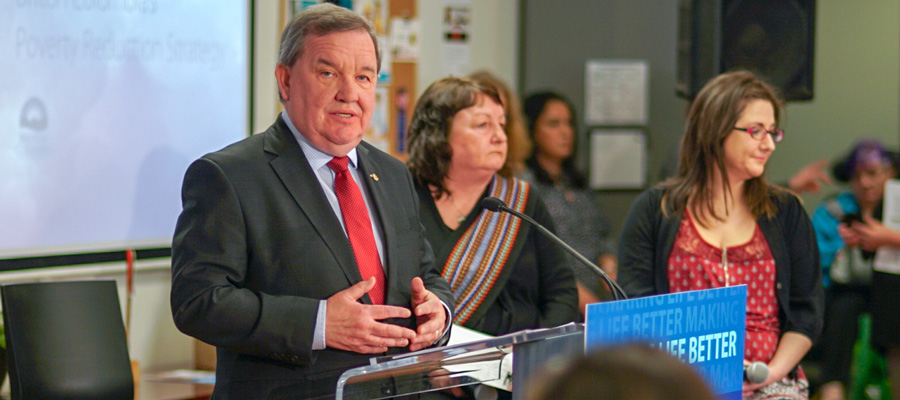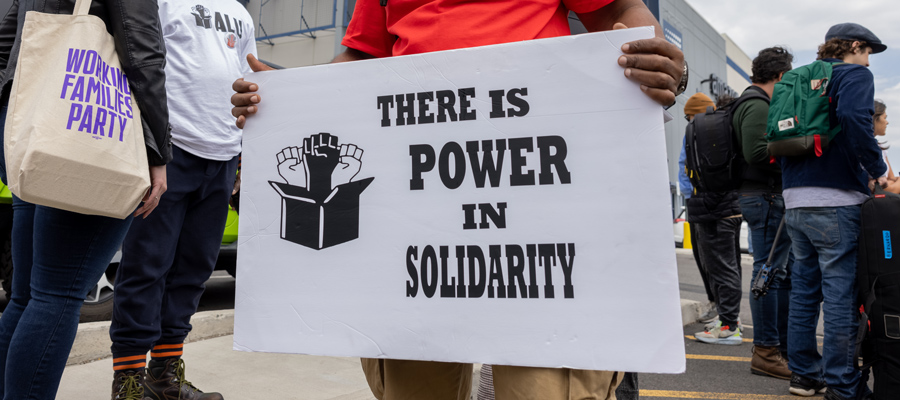BC’s first-ever poverty reduction strategy: An important step forward, but does it go far enough?

After ten years of community calls for action, BC has at long last joined the ranks of provinces with a comprehensive poverty reduction plan.
BC’s new strategy, TogetherBC, was unveiled yesterday. It sets out a framework to achieve the government’s legislated targets to reduce child poverty by at least 50 per cent and overall poverty by at least 25 per cent within five years.
There is much to celebrate in the plan. The strategy is an important document that outlines the provincial government’s approach to poverty reduction. It is encouraging to see that the strategy takes a cross-government approach and is comprehensive, recognizing the complexity of poverty and the vital importance of coordinated action across different ministries.
The government is now required to produce annual reports on the strategy’s progress, overseen by an independent advisory committee (as set out in the plan’s enabling legislation last October). This week the government announced the members of that advisory body, and it is populated by some very good people who are now tasked with holding the government to account on its commitments.
The plan identifies 12 key priority areas for action and reflects a good understanding of poverty. It is focused around four guiding principles: affordability, opportunity, reconciliation and social inclusion. The focus on Indigenous reconciliation and social inclusion is particularly important, and should help tackle the structural barriers and discrimination faced by groups disproportionately affected by poverty and homelessness. These efforts will be complemented by the commitment made in last month’s provincial budget to use gender-based analysis when implementing new programs.
The strategy takes a cross-government approach and is comprehensive, recognizing the complexity of poverty and the vital importance of coordinated action across different ministries.
The flagship elements of the plan have been previously announced. These include:
- The new BC child opportunity benefit announced in last month’s BC Budget (which boosts income supports to families with children, and extends the coverage from age six to 18);
- The scheduled increases to BC’s minimum wage;
- Landmark investments in affordable, quality child care;
- Investments in new affordable housing, and stronger protections for renters;
- Better supports for children and youth in foster care, higher rates for extended family caregivers, and postsecondary tuition waivers for former youth in care;
- Ending interest charges on postsecondary loans;
- Free access to adult basic education and improvements to employment training programs delivered by WorkBC;
- Ending deductibles to lower-income households under Fair PharmaCare; and
- Modest increases to income assistance and disability rates (of $150/month since the new government was elected almost two years ago).
Although these programs have already been announced, the roll-out of many is still ongoing. There is a lot to look forward to as these new initiatives are fully implemented.
Particularly notable (yet buried in news of the plan’s release) are some very welcome changes to the rules for accessing social assistance (welfare benefits), which will end a number of very punitive, arbitrary and unfair policies. Our research has documented that these rules systematically discourage, delay and deny access to social assistance for many British Columbians who desperately need help. Among the changes announced this week:
- Elimination of the two-year ‘independence’ rule, which denied many youth access to social assistance and forced them into hardship and homelessness;
- Income assistance recipients between the ages of 60 and 64 will no longer be forced to take early CPP, which had reduced their pension benefits for the rest of their lives and penalized people for falling on hard times right before retirement;
- Increased crisis supplements and other emergency supports for people receiving welfare;
- Equal access to income assistance for people without a fixed address;
- Higher asset limits, allowing people to keep their vehicle, and modernizing the definition of a‘spouse’ to better support people in need; and
- Reduced barriers for people to regain assistance when in need (if people leave assistance and then find they need to return, they no longer need to complete a full application from scratch—a complicated process that can take many weeks).
It’s great to see these harmful rules that delayed and denied assistance being eased.
But the plan should go much further to reduce the depth and breadth of poverty in BC. The great disappointment is that the plan does not include a substantial boost to social and disability assistance rates. These benefits remain far below the poverty line and keep people in deep poverty. They are completely inadequate to meet even the most minimal costs of food, shelter and other basic necessities of life. Yesterday’s plan offered no actions or timeline to change this.
A core weakness of the plan is with the government’s poverty reduction targets themselves, which are not ambitious. The legislated target is to reduce overall poverty by 25% over the next five years, from a 2016 base rate of 12% to 9%. Meaning, if the government meets its poverty reduction target, one in 11 British Columbians will still be living in poverty.
Recent data released by Statistics Canada reveals that BC’s overall poverty rate had already dropped to 10.3% in 2017. Meaning, before the new provincial government had introduced most of its poverty reduction measures, BC was already more than halfway to its 25% reduction target due to a combination of strong economic growth and federal government policies, including the Child Tax Benefit and the Guaranteed Income Supplement for single seniors.
There is no question the provincial government will meet its legislated overall poverty target—because it has set the bar so low.
TogetherBC speaks of the need to address both the depth and breadth of poverty. But we had hoped to see a bigger focus on reducing deep poverty (lifting those whose incomes are far below the poverty line) and eliminating the most extreme forms of poverty, such as homelessness and hunger.
The government’s approach to homelessness begins to reverse years of inaction and includes a welcome focus on prevention and coordination, with emphasis in the plan on making homelessness “rare,” “brief” and a “one-time occurrence.” But it is hard to imagine how homelessness can be effectively tackled without rapidly scaling up investments in new housing stock.
TogetherBC speaks of the need to address both the depth and breadth of poverty. But we had hoped to see a bigger focus on reducing deep poverty and eliminating the most extreme forms of poverty, such as homelessness and hunger.
The goal for which the CCPA and the BC Poverty Reduction Coalition have long advocated is to ensure all British Columbians have incomes that reach at least 75% of the official poverty line within two years of introducing a plan (75% of the poverty line is also how the federal government defines deep income poverty in its new national poverty reduction strategy).
In contrast, the BC government says its five-year plan will merely result in the average person in poverty having an income of 75% of poverty line (up from 65% as of 2017), which by definition means than many will still be forced to survive on incomes well below that 75% line.
If BC is going to meaningfully tackle deep poverty, the government must significantly increase welfare and disability rates over the next two years. In the longer term, income assistance rates must be set at a level that meets actual basic costs of living in this province—above the poverty line at a minimum—and be indexed to inflation to ensure that long freezes do not erode their value over time.
A significant boost to income assistance rates is also entirely manageable within the existing 2019 provincial budget, which forecasts a large surplus (nearly $1.5 billion counting the large contingency and forecast allowance). As we have previously noted, the cost of immediately increasing welfare and disability rates to 75% of the poverty line would be less than 1% of the total provincial budget (approximately $365 million).
Unfortunately, TogetherBC does not provide a path to higher income assistance and disability rates beyond the $50/month increase announced in BC Budget 2019. This represents a missed opportunity for the provincial government to significantly reduce deep poverty and risks leaving the poorest and most vulnerable British Columbians behind.
Income assistance rates and improved income security are listed in the TogetherBC document as a gap that was “named during the poverty reduction consultations, but not yet met by TogetherBC,” alongside “better access to good food for families” and “enhanced investments in affordable transportation.” Hopefully, this indicates the government still plans to act to fill these gaps in the near future.
In the meantime, we will continue to closely monitor progress, shine a light on the gaps in the strategy, and propose solutions for reducing both the breadth and depth of poverty—and hold the government accountable for delivering on a bold and ambitious poverty reduction strategy.
Topics: Children & youth, Poverty, inequality & welfare, Provincial budget & finance, Seniors


